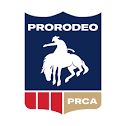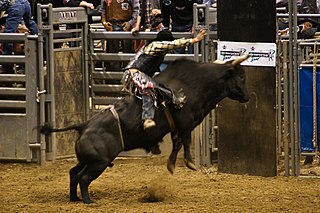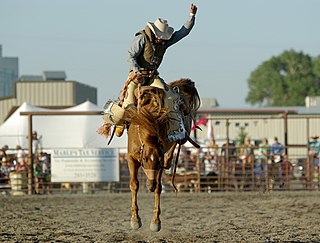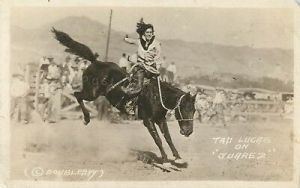Related Research Articles

Rodeo is a competitive equestrian sport which arose out of the working practices of cattle herding in Spain and Mexico, expanding throughout the Americas and to other nations. It was originally based on the skills required of the working vaqueros and later, cowboys, in what today is the western United States, western Canada, and northern Mexico. Today, it is a sporting event that involves horses and other livestock, designed to test the skill and speed of the cowboys and cowgirls. Professional rodeos generally comprise the following events: tie-down roping, team roping, steer wrestling, saddle bronc riding, bareback bronc riding, bull riding, breakaway roping, and barrel racing. The events are divided into two basic categories: the timed events and rough stock events. Depending on sanctioning organization and region, other events such as goat tying and pole bending may also be a part of some rodeos. The "world's first public cowboy contest" was held on July 4, 1883, in Pecos, Texas, between cattle driver Trav Windham and roper Morg Livingston.

Chugwater is a town in Platte County, Wyoming, United States. As of the 2020 census, the town population was 175. The High Plains town is located 45 miles north of Cheyenne and 25 miles south of Wheatland.

Bronc riding, either bareback bronc or saddle bronc competition, is a rodeo event that involves a rodeo participant riding a bucking horse that attempts to throw or buck off the rider. Originally based on the necessary buck breaking skills of a working cowboy, the event is now a highly stylized competition that utilizes horses that often are specially bred for strength, agility, and bucking ability. It is recognized by most rodeo organizations such as the Professional Rodeo Cowboys Association (PRCA) and the International Professional Rodeo Association (IPRA).
Peter Charles Knight was a Canadian and World Champion Rodeo Bronc Rider. Knight was the acclaimed "King of the Cowboys" of the 1930s, and held the Rodeo Association of America title "World Champion Bronc Rider" for 1932, 1933, 1935, and 1936. The Rodeo Hall of Fame in the National Cowboy and Western Heritage Museum inducted Knight in 1958. The Ellensburg Rodeo Hall of Fame inducted him in 1998. The ProRodeo Hall of Fame in Colorado Springs, Colorado, inducted Knight in the Saddle Bronc Riding category when it opened its doors in 1979.

The Professional Rodeo Cowboys Association (PRCA) is the largest rodeo organization in the world. It sanctions events in the United States, Canada, and Mexico, with members from said countries, as well as others. Its championship event is the National Finals Rodeo (NFR). The PRCA is headquartered in Colorado Springs, Colorado, United States.

The ProRodeo Hall of Fame and Museum of the American Cowboy was opened in August 1979 as a museum designed to "preserve the legacy of the cowboy contests, the heritage and culture of those original competitions, and the champions of the past, present and future." It is located in Colorado Springs, Colorado, and only inducts Professional Rodeo Cowboys Association and Women's Professional Rodeo Association members. It is the "only museum in the world devoted exclusively to the sport of professional rodeo."

Cowboy culture is the set of behaviors, preferences, and appearances associated with the attitudes, ethics, and history of the American cowboy. The term can describe the content or stylistic appearance of an artistic representation, often built on romanticized impressions of the wild west, or certain aspects of people's lifestyle, such as their choices in recreation, apparel, and western or southwestern cuisine.

Cheyenne Frontier Days is an outdoor rodeo and western celebration in the United States, held annually since 1897 in Cheyenne, Wyoming. It bills itself as the "World's Largest Outdoor Rodeo and Western Celebration." The event, claimed to be one of the largest of its kind in the world, draws nearly 200,000 annually. Lodging fills up quickly during the peak tourist season throughout southern and eastern Wyoming, into northern Colorado and western Nebraska. The celebration is held during the ten days centered about the last full week of July. In 2008, Cheyenne Frontier Days was inducted into the ProRodeo Hall of Fame.

The Cheyenne Frontier Days Old West Museum is located in Cheyenne, Wyoming, United States. The museum was founded in 1978. It is a 501(c)(3) non-profit organization, dedicated to interpreting, conserving and exhibiting the history and material culture of Cheyenne, Cheyenne Frontier Days, the State of Wyoming and the American West. The museum features the Cheyenne Frontier Days Hall of Fame. Permanent exhibits include Western horse-drawn carriages and wagons, the history and memorabilia of Cheyenne Frontier Days rodeo celebration, local history of Cheyenne, pioneer artifacts and clothing, and Western and folk art. The Cheyenne Frontier Days Old West Museum is home to the "World’s Largest Outdoor Rodeo and Western Celebration" with its permanent exhibit on the history of Cheyenne Frontier Days.

Casey Duane Tibbs was an American professional rodeo cowboy, and actor.

The Bucking Horse and Rider (BH&R) is a registered trademark of the U.S. state of Wyoming. In 1936, Wyoming trademarked the image for the state's license plates. However, the state's usage of the logo can be traced back to as early as 1918. Wyoming is popularly known as the "Cowboy State," in part because of the use of the bucking bronco as its symbol. The University of Wyoming at Laramie athletic teams are nicknamed the Cowboys and Cowgirls, both of which use the bucking horse and rider logo on their uniforms.

A stock contractor is an individual or business that provides animals for rodeo competition. Stock contractors supply rough stock - bucking horses for saddle bronc and bareback bronc riding and bucking bulls for bull riding, plus steers for steer wrestling and team roping, plus calves for calf roping and breakaway roping events. The use of stock contractors who specialize in providing these animals has produced a more uniform range of bucking stock which is also quieter to handle.
Warren Granger "Freckles" Brown was a hall of fame American rodeo cowboy from Wheatland, Wyoming. His career spanned from 1937 to 1974, competing in bull riding, saddle bronc riding, bareback bronc riding, team roping, and steer wrestling. He was the World Bull Riding Champion in 1962. Brown was inducted into the ProRodeo Hall of Fame in Colorado Springs, Colorado, for bull riding in 1979. He was also inducted into the inaugural class of the Bull Riding Hall of Fame in Fort Worth, Texas, in 2015. Brown was most famous for riding Tornado, who had an undefeated record of 220 riders. Brown was also a close friend and mentor of Lane Frost.
Midnight (1916–1936) was a bucking horse who in 1979 was inducted into the ProRodeo Hall of Fame.

A bucking horse is any breed of horse, male or female, with a propensity to buck. They have been, and still are, referred to by various names, including bronco, broncho, and roughstock.
Prairie Rose Henderson, was considered the first female to do bronc riding and recognized as one of the first female professional athletes. In 2008, she was inducted into the Cowgirl Hall of Fame.

Tad Lucas is a ProRodeo Hall of Fame cowgirl inductee.
Medicine Woman #302 (2003-2021) was an American rodeo bucking horse that was specialized in saddle bronc riding. She competed in the Professional Rodeo Cowboys Association (PRCA) and was a four-time PRCA Saddle Bronc Horse of the Year. She won the award in 2011, 2014, 2015, and 2016. She also was the Saddle Bronc Horse of the National Finals Rodeo (NFR) in 2010 and 2015. In 2022, she was posthumously inducted into the ProRodeo Hall of Fame.
Dirty Jacket #474 is an American rodeo bucking horse that is specialized in saddle bronc riding. He competes in the Professional Rodeo Cowboys Association (PRCA) and won the 2014 and 2015 PRCA Bareback Horse of the Year award.
Descent was a bucking horse who was specialized in saddle bronc riding and competed in the Rodeo Cowboys Association. He is a six-time Bucking Horse of the Year awardee. He won the award in 1966, 1967, 1968, 1969, 1971, and 1972. He is also a 1979 ProRodeo Hall of Fame inaugural inductee.
References
- 1 2 3 4 5 6 "Kelsey Bray, Blazin' saddle". Wyoming Tribune-Eagle . Archived from the original on September 23, 2013. Retrieved September 23, 2013.
- 1 2 3 "Clayton Danks (1879 - 1970)". Ancestry.com. Archived from the original on July 12, 2015. Retrieved September 21, 2018.
- 1 2 "A Little Bit Of History: Clayton Danks-Bronc Rider and Sheriff" . Retrieved September 20, 2018.
- 1 2 3 "Frontier Days: Clayton Danks". wyomingtalesandtrails.com. Retrieved September 23, 2013.
- ↑ "Cheyenne Frontier Days Hall of Fame Inductees". Cheyenne Frontier Days Old West Museum. Retrieved October 2, 2018.
- 1 2 "Questions & Answers". lemen.com. Retrieved September 23, 2013.
- ↑ "Danks, Clarence Clayton". Burial Search. Retrieved May 29, 2019.
- ↑ "Danks, Marie". Burial Search. Retrieved May 29, 2019.